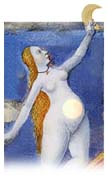From
earliest times, people have been fascinated by the moon. They realized
the vital connection between a woman's monthly menstrual (from
mensis,
Latin for "moon") cycle, and the waxing and waning of
the moon. They also recognized that the moon controls the tides,
whose ebb and flow parallels the organic rhythms of female fluids.
Because of these connections, the moon has been universally associated
with femininity and women's procreative power. In popular ancient
Israelite belief, too, the moon was thought to influence fertility;
the women wore moon-shaped pendants, as discovered in archaeological
finds and as mentioned by Isaiah in his admonition: "On that
day, my Lord will strip off the finery of the anklets, the fillets,
and the crescents."
[1]
Jewish woman have long celebrated the special female symbolism of
the moon. From the talmudic period to our day, Rosh Hodesh, the
minor festival of the New Moon, has been especially sacred to Jewish
women. According to legend, the women in the wilderness refused
to contribute their jewelry to make the Golden Calf, and were rewarded
for their faithfulness by being granted the New Moon as a day off
from work.
[2]
For many centuries, Jewish women refrained from doing heavy work
on this day.
In recent
years, Rosh Hodesh has been revived as a special women's festival.
Women have formed Rosh Hodesh group, which meet on the New Moon
to celebrate and study together. These groups have created new
rituals which bring together ancient symbolism of moon, water
and women.[3]
 The
text of the blessing of the New Moon (kiddush levanah,
recited at the reappearance of the lunar crescent) alludes to
a Talmudic legend according to which the sun and moon were equal
in luminosity at the time of creation; God subsequently diminishes
the moon's radiance, but regrets having done so. The midrash predicts
that in the Messianic Age, the moon will regain the radiance and
luminosity it enjoyed at the beginning of time.[4]
The
text of the blessing of the New Moon (kiddush levanah,
recited at the reappearance of the lunar crescent) alludes to
a Talmudic legend according to which the sun and moon were equal
in luminosity at the time of creation; God subsequently diminishes
the moon's radiance, but regrets having done so. The midrash predicts
that in the Messianic Age, the moon will regain the radiance and
luminosity it enjoyed at the beginning of time.[4]
Among
the Kabbalists, the moon has traditionally represented the Shekhinah,
God's feminine aspect, whose exile is symbolized by the moon's
monthly waning. Thus, for them, the blessing of the new moon and
the anticipation of Rosh Hodesh, marking the moon's return, came
to symbolize the renewal of hope in the restoration of Divine
Unity.
In a contemporary
reading of this midrash, Arthur Waskow refers to a future time
when Jewish women will acquire full equality within the tradition.
"In this orientation," writes Waskow, "Rosh Hodesh
becomes a renewal both of God's presence in the world —
the Shekhinah, a female aspect of God —
and of the female side of the human race and the human soul."[5]
|
[1]
Isaiah 3:18 [back]
[2] Tosafot to Rosh Hashanah
23a [back]
[3] Adelman, Miriam's Well [back]
[4] Psalms 89:38; Hullin 60b [back]
[5] Arthur Waskow, Seasons of our Joy
[back] |
|
 From:
The Encyclopedia of Jewish Symbols, Ellen Frankel
and Betsy Platkin Teutsch. Jason Aronson, New Jersey
1995 |